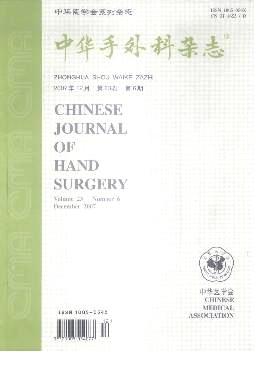Comparison of two kinds of flaps in repair of oblique wounds on the palmar of the fingertip
引用次数: 0
Abstract
Objective To compare the clinical efficacy of V-Y flap with neurovascular pedicle and dorsal branch of the terminal digital artery flap in repairing oblique wounds on the palmar side of the fingertip. Methods From September 2016 to June 2018, 42 patients with oblique fingertip wounds were treated. Among them, 20 cases were repaired with V-Y flaps with neurovascular pedicles (Group A), and 22 cases were repaired with dorsal branch of the terminal digital artery flaps (Group B). The operation time, complications, functional evaluation results and patient satisfaction scores were compared between the two groups. Results The postoperative follow-up time of group A was 5 to 25 months, with an average of 12.9 months, while that of group B was 5 to 26 months, with an average of 13.1 months. There was no significant difference in follow-up time between the two groups (P>0.05). The average operation time in group A was (27.1±1.9) minutes shorter than that in group B (38.0±4.9) minutes, and the incidence of complications in group A was 15.0% higher than that in group B 4.5%. The differences were statistically significant (P 0.05). According to the upper extremity functional evaluation criteria issued by the Hand Surgery Society of the Chinese Medical Association, the results were graded as excellent in 13 cases and good in 4 cases with the excellent and good rate being 85.0% for group A; the results were graded as excellent in 11 cases and good in 9 cases with the excellent and good rate being 90.9% for group B. The excellent and good rate of functional assessment for group A was lower than that for group B. The difference was statistically significant (P<0.05). Conclusion Compared with V-Y flaps with neurovascular pedicles, the dorsal branch of the terminal digital artery flaps have more advantages in repairing oblique wounds on the palmar side of the fingertip. Key words: Finger injuries; Surgical flaps; Fingertip wound; Effect comparison两种皮瓣修复指尖掌侧斜切伤的比较
目的比较指末动脉背支神经血管蒂V-Y皮瓣修复指掌侧斜创面的临床疗效。方法2016年9月~ 2018年6月对42例指尖斜创面患者进行治疗。其中带神经血管蒂的V-Y皮瓣修复20例(A组),指端动脉背支皮瓣修复22例(B组)。比较两组手术时间、并发症、功能评价结果及患者满意度评分。结果A组术后随访5 ~ 25个月,平均12.9个月;B组术后随访5 ~ 26个月,平均13.1个月。两组随访时间比较,差异无统计学意义(P < 0.05)。A组平均手术时间(27.1±1.9)min比B组(38.0±4.9)min短,并发症发生率比B组高4.5%。差异有统计学意义(p0.05)。按照中华医学会手外科学会上肢功能评价标准评定,优13例,良4例,优良率85.0%;A组功能评估优良率低于b组,差异有统计学意义(P<0.05)。A组功能评估优良率低于b组,差异有统计学意义(P<0.05)。结论与带神经血管蒂的V-Y型皮瓣相比,指终动脉背侧支皮瓣修复指掌侧斜创面更有优势。关键词:手指损伤;外科皮瓣;指尖的伤口;效果的比较
本文章由计算机程序翻译,如有差异,请以英文原文为准。
求助全文
约1分钟内获得全文
求助全文

 求助内容:
求助内容: 应助结果提醒方式:
应助结果提醒方式:


